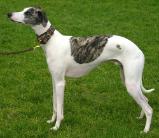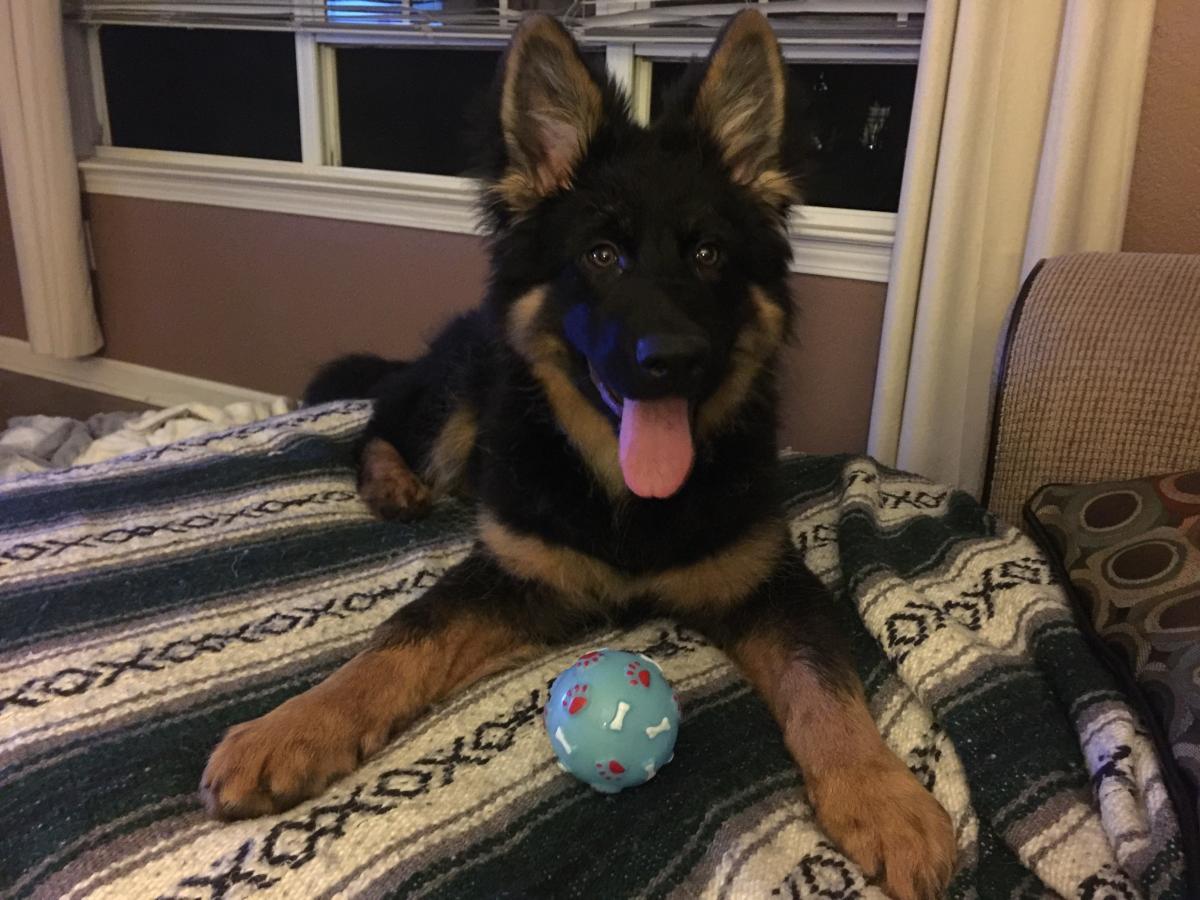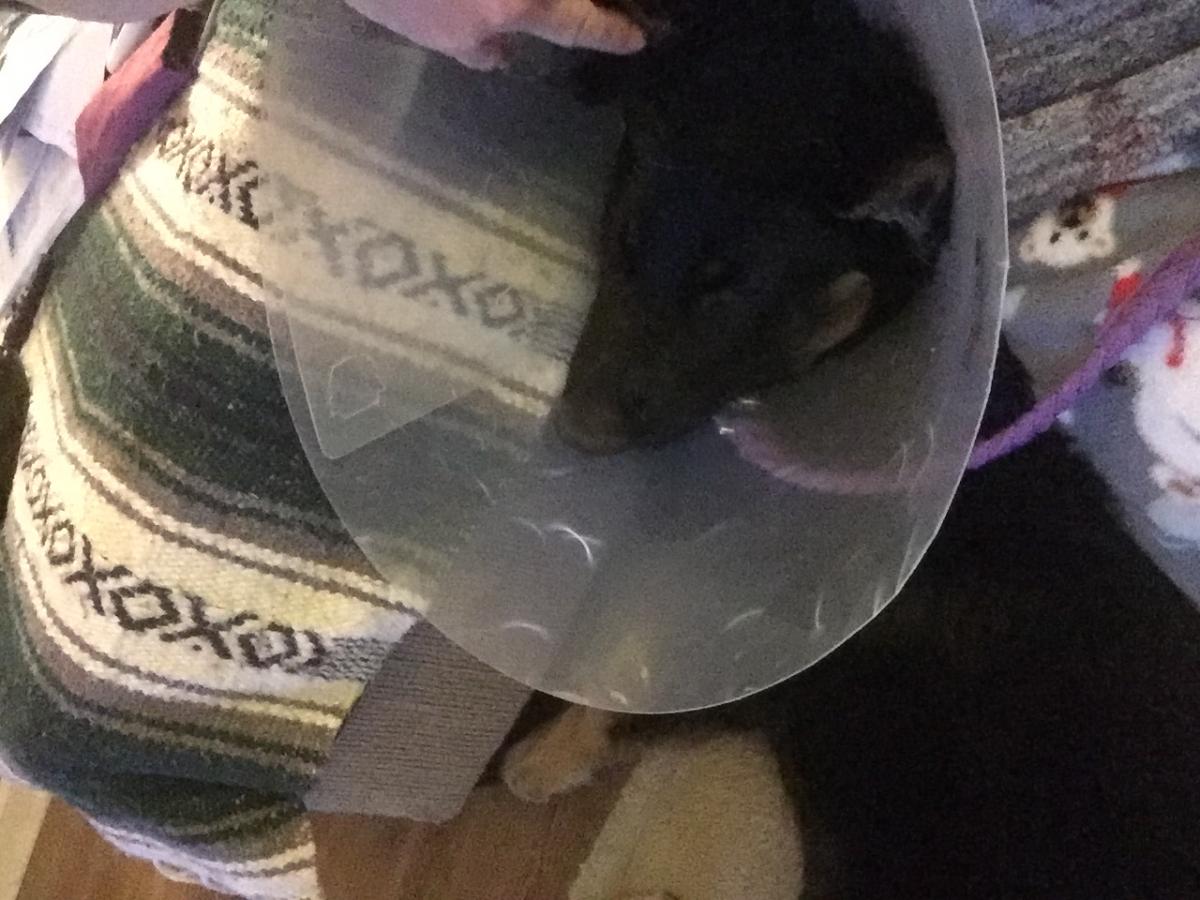
This is a placeholder text
Group text
by junkmail2014nov on 03 February 2018 - 19:02
Good Morning,
It was an extremely rough night for both of us. More so for her than myself. I confess I am looking for opsinions as to whether I made the right decision making her suffer this much, this early in her very short life. (Anyone wishing previous history see thread named " OCD Puppy - Genetic? Treatment Options?" Please feel free to offer them.
Question 1: Post-Op Care - We had a rough night. I am keeping track of her intake/output and medicines. She thrashed around quite a bit so the Orthopedic surgeion recommended we get on a schedule of 150mg Trazadone q 8 hours and do this for the first 4-5 days. I have started this and this seems to work much better. I have mixed her food with quinoa, organic chicken broth, and her glucosamine chondroitin powder to make a paste. I make sure I am measuring out one and one half cup of dry to mix into it. Then I take the paste and stuff it into every conceivable hollow toy/bone I can find and let her work on getting her food that way. I am using light massage on her back and rear legs taking care to watch if she says "enough." I keep her in the 100lb crate when I cannot be exactly beside her else when I am studying she is leashed and sleeps on her bed on the screened in porch right next to me. This way she gets sunshine and smells. Its 60 degrees outside. I have called Earthfare and ordered some of the supplements Jessejones recommended, particularly for her liver. Right now I am also supplementing her water intake with ice as she likes to chew it. This keeps her peeing quite a bit but it will help with flushing the liver and kidneys due to the medicine she has to be on right now.
Question 2: I have the images relevant to this pups surgery. The Radiographs from 25 JAN 2018 when we were attempting to figure out what was going on are not tranferred to me yet. However, I have the radiographs from just before surgery. I am also including the two, separate, radiologists' reading of both sets of radiographs.
- The first finding of a separate, radiological and orthopedic specialist was as follows:
- CASE HISTORY:
PATENT PRESENTED FOR RELUCTANCY TO GET UP, OCCASIONALLY LAME ON REAR LEFT HND, VERY PAINFUL ON PALPATION LEFT STIFLE JOINT
DESCRIPTION:
DOES THIS DOG HAVE EVDENCE OF HYPERTROPHC OSTEODYSTROPHY? OR PANOSTEITIS?- Findings:
Ventrodorsal views of the pelvis and hindlimbs as well as lateral and craniocaudal radiographs of the left hind limb are provided for evaluation (total of 4 images).
There is a focal area of flattening of the lateral femoral condyle bilaterally on the ventrodorsal view as well as a possible subchondral defect seen in the more cranial femoral trochlea on the lateral view of the left stifle. Evaluation of the left stifle joint space is limited on the lateral viaw of the left stifle due to mild positional rotation and the presence or absence of joint effusion cannct be definitively determined. No degenerative changes of the left stifle are identified. The tibial tuberosity and other associated physes appear normal for the age of the patient. No additional developmental abnormalities (such as hypertrophic osteodystrophy, penosteitis, etc.), traumatic injuries, aggressive lesions or other osseous abnormalities are seen to explain the clinical signs. The coxofemoral joints and pelvis are normal with no degenerative joint disease, subluxations, or other changes seen. There is the impression of reduced left hind limb musculature when compared with the right. The patellas are in a normal anatomic position. No abnormalities of the caudal lumbar or lumbosacral spine are seen on the ventrodorsal view. No abnonnalities are seen in the included portion ct the abdomen. Assessment:
Subchondral defect seen in the more cranial femoral condyle on the lateral view of the left stifle as well as mild flattening of the lateral femoral condyles bilaterally on the ventrodorsal view. These findings are most concerning for bilateral stifle osteochondrosis given the age of the patient and radiographic findings. No definitive degenerative changes of the left stifle are seen. The presence or absence of left stifle joint effusion cannot be determined given as a result of positional rotation. A repeat lateral view of the left stifle with straighter positioning as well as a lateral view of the right stifle are suggested for further assessment, especially given the suspected bilateral changes on the verrtrodorsal view of the pelvis.
Mid left hind limb muscle atrophy may be secondary to chronic lameness; however, clinical correlation is suggested to corroborate this finding.
No additional dewlopmental abnormalities (such as hypertrophic osteodystrophy, penosteitis, etc.), traumatic osseous or physeal injuries or aggressive lesions are seen to explain the clinical signs.
Normal coxofemoral joints and pelvis. No degenerative joint disease, subluxation or ether abnormalities are seen.
- Findings:
- CASE HISTORY:
- The second findings of a different radiological and orthopedic specialist is as follows:
- CASE HISTORY:
PREVDUS RADOGRAPHS SENT ON 1125118 EVDENCE OF OCD ALONG LEFT FEMORAL CONDYLES. DR. MATTHEWS THOUGHT THERE WAS EVDENCE OF BlATERAL OSTEOCHONDROSIS.
DESCRIPTION:
INCLUOED ARE REPEAT LATERAL VEW OF BOTH LEFT NO RIGHT STFLES FOR FURTHER ASSESSMENT. OWNER ALSO WANTED SHOULDERS EVALUATED BUT NO CLINICAL. SIGNS ARE SEEN ON THE FRONT LIMBS. - FINDINGS:
Orthogonal rediographs of the bilateral s1ifle joints and bilaleral shoulder joints are presented for evaluation. 10 radiographs are available for review.
There are no speck osseous d soft tissue abnormalities noted at the bilnral shoulder joints. The portions of the bilateral elbow joints seen are unremarkable.
The bilateral coxofemoral joints are unremarkable. There is persistence of reduced muscle mass at the left pelvic limb.
There is persistence of the region of flatlening at the lateral condyle of the left distal femur. A similar lesion is noted at the lateral condyle of the right distal femur. These lesions are seen both on craniocaudal end lateral projections. The remainder of the structures at the stifle joints are unremarkable. There is no current radiographic evidence for stifle joint effusion.
ASSESSMENT:
1) Subchondral defects at the lateral femoral condyles of the bilateral femurs are consistent with bilateral osteochondrosis. There is no current radiographic evidence for stifle joint effusion or degenerative change.
2) Mid left pelvic limb muscle atrophy may be consistent with chronic lameness. 3) Radiographically unremarkable pelvis end coxofemoral joints.
4) Radiographically unremarkable bilateral shoulder joints.
- CASE HISTORY:
And here are views of the right and left stifle/knee joints as well as the pelvis. If anyone has any expert opinions please offer them. To be very clear, any comments offered are understood to be opinions only and NOT those of actual, medical, vet/ortho specialist. Again and as always, thank you all in advance.
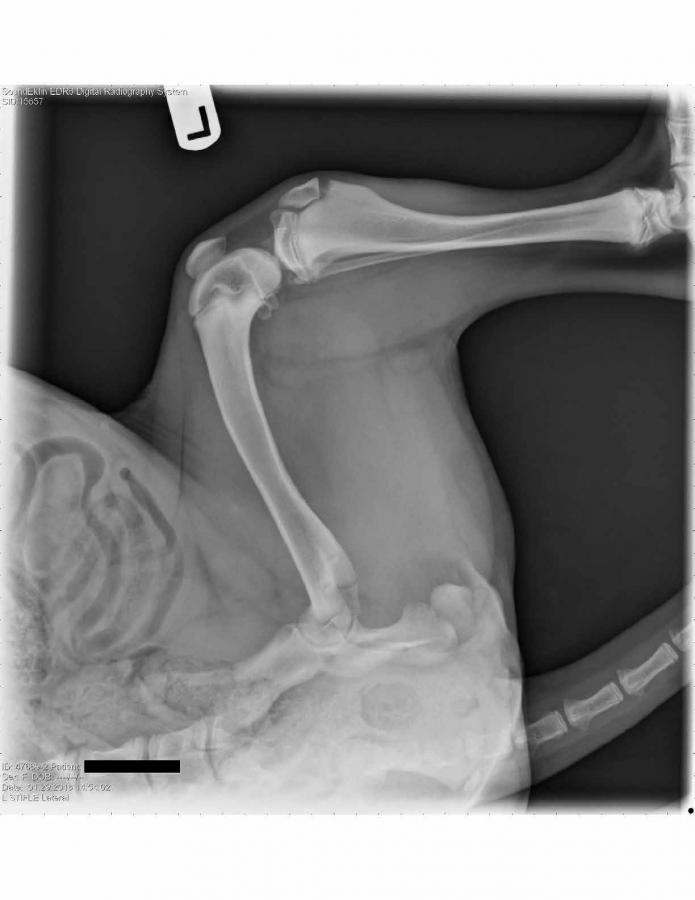
.jpg)
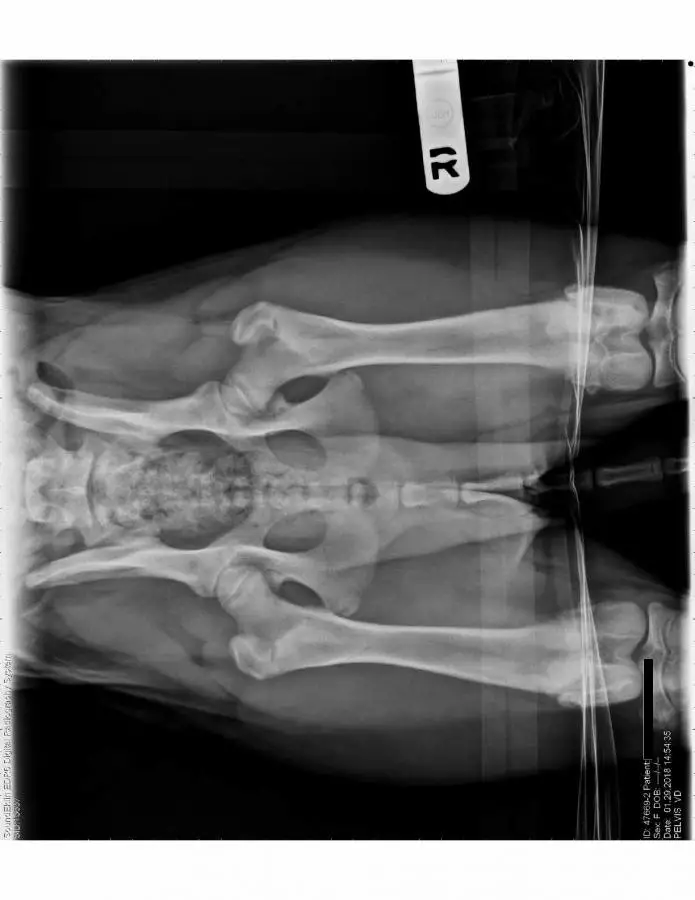
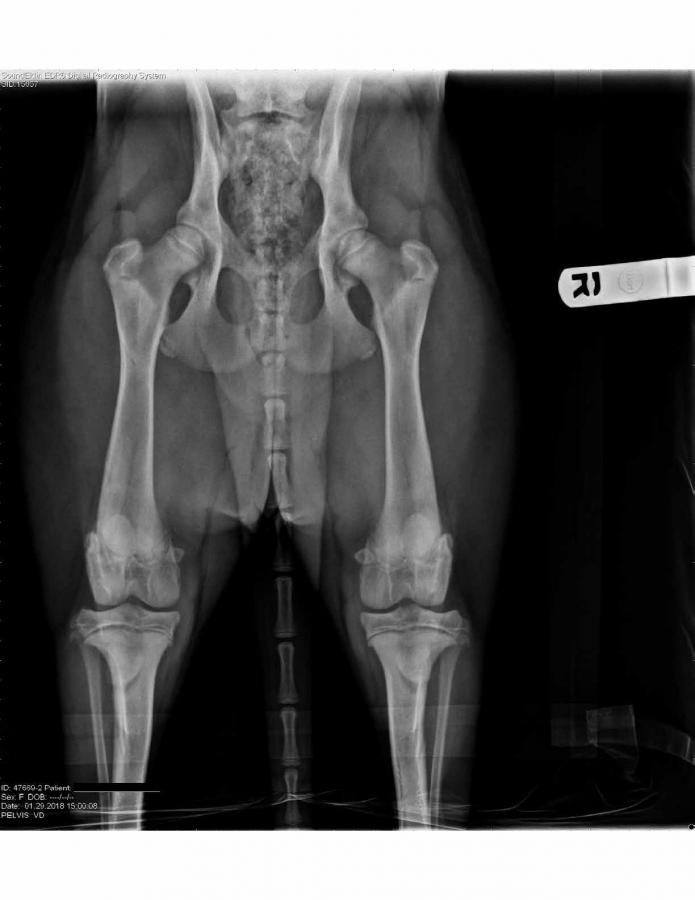
by beetree on 03 February 2018 - 22:02
Are you looking for assurance that your vet is competent? I don’t find a question being asked. You seem to be attentive enough in your care. I hope it helps the patient recover quickly!
by junkmail2014nov on 03 February 2018 - 22:02
The choice to do surgery is related to the research I have found which states that once the pup enters into her heat, hormonal changes signify to the body to begin bone calcification. That would mean the window of opportunity to remove the lesions and wait for the body’s natural systems to provide good blood supply to the area for growth would be diminished if not completely closed.
So the question isn’t the competency of the vets, the question is the choice of the owner. The first question is, of all that I have listed that I am doing for her recovery, do these things seem appropriate and does anyone have any other recommendations?
by Jessejones on 04 February 2018 - 01:02
First and (to me) foremost right now...
I wouldn’t introduce any new food right now. The last thing you want is for her to get diarrhea at this time, when walking outside is difficult. Keep her on her old food at least this week. Wait for a week or two and then only introduce one new thing at a time. You will want to avoid diarrhea at all cost right now.
I’m assuming the chicken broth is homemade? I would not recommend store bought as it is homogenized/pasteurized and has no nutritious worth and a lot of sodium. Homemade is wonderful, but can have a fair amount of chicken fat, which, if she is not used to can cause D.
Otherwise she sounds like she is in the best hands.
Careful if you use xpen...she might likely try to jump over it while you are out of the room. It only takes the blink of an eye for a jump attempt....and you don’t want that now at this point at all.
A little very soft massage is ok, but only to stimulate the lymph flow...this is a very soft sweeping motion with your fingers from the end of the extremity to the mid body, in one direction only. Don’t massage around the stitches or staples right now.
A word of personal advice, only because I have been there often...don’t second guess yourself anymore. The op was done and you can’t undo it anyway. Look only forward. You did the best possible with the info given to you by the vets. Don’t look back and and try to second guess now, don’t punish yourself.
Your pup might look forlorn now, but dogs usually heal incredibly fast! She probably will be her old self before you know it. Very cute girl in the photo you posted, please post another once the cone is off.
by junkmail2014nov on 04 February 2018 - 02:02
Thanks Jessejones. You’re right. Surgery is done. And that is the same thing my friend and another friend who is a vet tech back where I last moved from told me: I have made the best decision I could given the information. It just sucks. I just kept thinking if we took more xrays or if I took her to more specialists we'd find something easily manageable and not this serious. Ah well. Time to move forward.
Good advice on the diet. Thanks. I will use it. Here’s a good pic of her prior to surgery. She was 4 months old. I hope she looks this happy again soon. And we are moving to the Great White North and she DOES love the snow so.... :-) She's sleeping right now so I'm going to try to get some too.
by Jessejones on 04 February 2018 - 03:02
She is a beautiful long coated girl! What a mask! Yes, you are very lucky and take good care of this girl! I have a long coat white shepherd 7 mo, and the same ears as your girl.
She will be happy again...I can see it in her eyes. She will come through this fine. These dogs have grit!
by Hundmutter on 04 February 2018 - 06:02
by junkmail2014nov on 04 February 2018 - 12:02
Thank you, Hundmutter, Jessejones. I appreciate the encouragement. And I got your other two PM’s Hundmutter. 100% agree and 100% am responsible. There is context for the erroneous decision I made, not excuses. None of which have anything to do with what I knew, factually in my gut and with my eyes to be true, which I should have listened to. :-( Live and learn. My late father used to always tell me, “You make the best decisions you can with the information you have at the time.” And he ALWAYS told me to pay attention to my “gut.” And whenever I have ignored my “gut feelings” I have always paid the price. Yes. We are using food filled toys, hollow bones; I take dixie bathroom cups and fill them to make ice chunks of food; we do petting exercises and handling exercises with chunks of chicken as treats, (her FAV!!!), all chicken broth is homemade, all chicken homemade. We do frozen bananas; and when she is refusing water I hand feed ice from the ice maker to keep her taking in water. After all, she IS only going to be 6 months old this coming Thursday so she’s still teething and needs something to chew. I’ve researched and found an at home trainer who specializes in helping to keep up mental stimulation in crated dogs recovering from major surgeries. She will be here today at 1 to begin working with her. She is recommended by the Ortho and the Rehab vets. Once her stitches are out in a week and a half she starts PT and Acupuncture. I am tracking ALL input/output; bathroom; mental status; etc in a log. Courtesy of 25+ years in human medicine. Her Fentanyl patch will come off at 1 today. We are on a regimen of the Trazodone, 150mg q 8 hours and this seems to have worked. We made it through the night only getting up once. She’s even shown and interest in play tug of war, (GENTLY!!!!) with a rope toy. So I have hope. And she is still very happy to see me in the morning and is still bright and wagging her tail and leaning up against me every time I go to pet her, or talk to her or anything. All of this gives me hope. Truly her temperament and intelligence are some of her best qualities, in addition to being cute as hell.
Jessejones, do you recommend the liver supplements to start now given her pharmocology regimen? I am keeping her well flushed with water and she's peeing/pooing well. No strain when pooing yet. Do dogs normally get the same issues with pain/narcotic based medications that humans do with regards to slowing down the bowel? I know my older girl did but the vet said that was due to her age. I had to supplement with pumpkin mix for that.
by Jessejones on 04 February 2018 - 18:02
Also, you can start with the tumeric golden paste too (link for the recipe in previous email) as it helps with pain as well as being an excellent antioxidant.
As always, check with vet, but this is pretty standard protocol.
Constipation can happen anytime mobility is capped, through anesthesia and meds that slow the intestinal peristaltic. Very ripe bananas and good fluid intake can help soften stool (green or less ripe bananas will firm stool).
Great that you have a trainer coming that specializes in crated dogs.
by junkmail2014nov on 06 February 2018 - 02:02
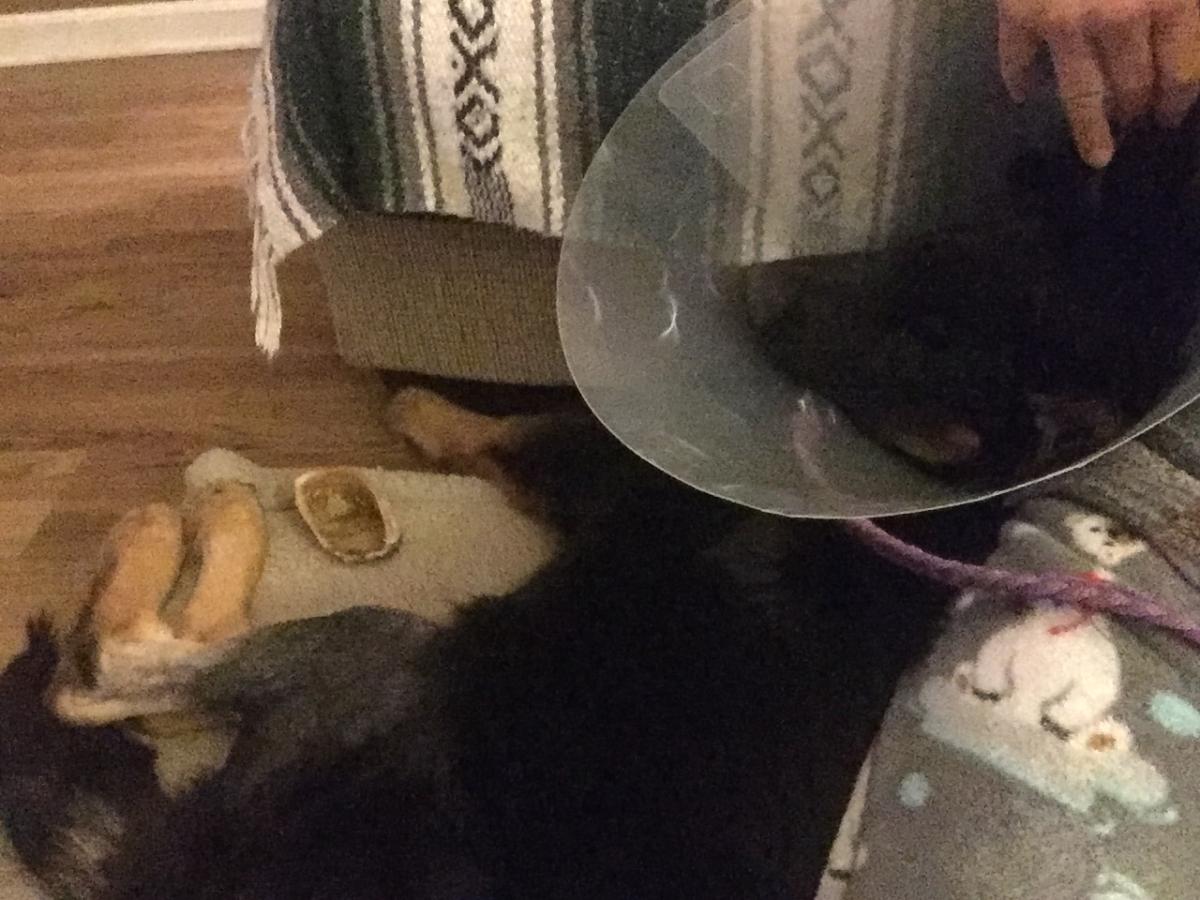
Contact information Disclaimer Privacy Statement Copyright Information Terms of Service Cookie policy ↑ Back to top
